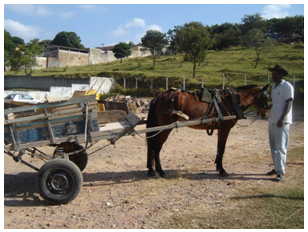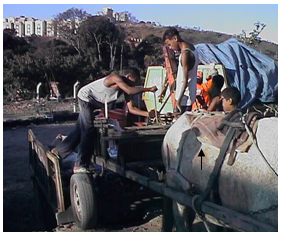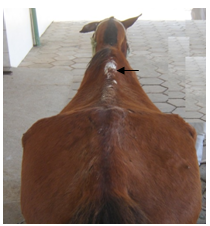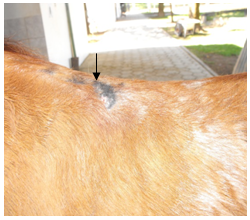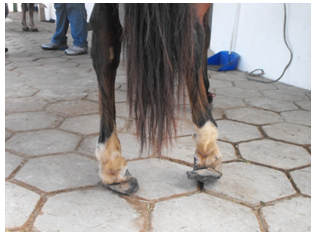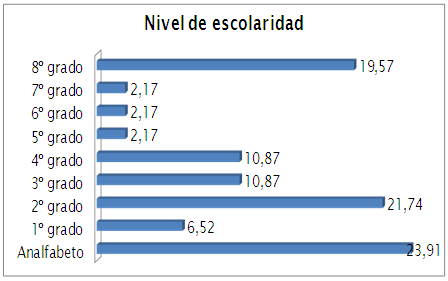|
Characterization of the population, work and handling of carter’s animals in Belo Horizante
RESEARCH ARTICLE
Priscila Fantini1
1 Teachers Federal University Minas Gerais
Received: 28 march 2019 and Approved: 16 april 2019, Updated: 18 june 2019
DOI: 10.17151/vetzo.2019.13.2.6
ABSTRACT. Introduction: Carters are a special class of workers responsible for the collection, transportation, and disposal of waste and for participating in the collection and classification of waste with high socio-economic contribution and environmental society. Aim: The aim of this study is to describe the clinical and social aspects related to the type and condition of work done by animals. Methods: 61 horses were included in this study. Each owner took a survey that contained the identification and characterization of the animals, state of the saddle, work utensils, food handling, and animal’s medical history. The responses were assessed by frequency distribution. Results: According to the responses of the owners, 76.6% (36/47), 21.28% (10/47), and 2.13% (1/47) saddles were in good condition, normal state, only poor state, respectively. A total of 14 carters did not respond to this question. The majority of the owners reported the use of saddles for as long as possible and sometimes the use of foam inserts, pieces of cloth, rugs, or blankets as well, particularly when there was erosion of the protection of the lowest saddle, known as sweating. In some cases, cables were used to maintain this protection, leading to injuries on the animal’s skin. Conclusion: The educational level of the owners of the traction animals has a huge influence on the rearing of these animals and its consequences. Future studies on biomechanics would be of great significance for the empirical correction of the efforts to which these animals are subjected. More studies are necessary to quantify the influence of environment on lesions of this type of equines.
Keywords: horses, carters, social work, education
Caracterización de la población, del trabajo y del manejo de los animales de los carretilleros en Belo Horizonte
RESUMÉN. Introducción: los carretilleros son una clase especial de trabajadores responsables de la recolección, transporte y disposición de desechos, participando del proceso de recolección y clasificación de desechos, con gran aporte socio-económico y ambiental en la sociedad. Objetivo: El objetivo de este estudio es describir los aspectos clínicos y sociales relacionados con el tipo y la condición del trabajo realizado por los animales. Métodos: 61 caballos fueron incluidos en este estudio. Cada propietario realizó una encuesta que contenía la identificación y caracterización de los animales, el estado de la silla de montar, los utensilios de trabajo, la manipulación de alimentos y el historial médico de los animales. Las respuestas fueron evaluadas por distribución de frecuencia. Resultados: De acuerdo con las respuestas de los dueños el 76,6% (36/47) de las sillas se encontraban en buenas condiciones, un 21,28% (10/47) en regular estado, y solo un 2,13% (1/47) en mal estado; catorce carretilleros no respondieron a esta pregunta. La mayoría de los propietarios informaron utilizarla el mayor tiempo posible y algunas veces piezas de espuma, trozos de tela, alfombras o mantas, sobre todo cuando no había erosión de la protección de la silla más baja, conocida como sudoración. En algunos casos, cables son utilizados para mantener esta protección, dando lugar a lesiones en la piel del animal. Conclusión: El nivel educativo de los propietarios de animales de tracción tiene gran influencia en la crianza de estos animales y sus consecuencias. Los futuros estudios sobre la biomecánica del sorteo será de gran importancia para la corrección empírica de gestiones a la que estos animales son sometidos. Son necesarios más estudios para cuantificar la influencia del ambiente sobre las lesiones en este tipo de caballos.
Palabras clave: equinos, carretilleros, trabajo social, educación
INTRODUCTION
Carters are a special class of workers responsible for the collection, transport, and disposal of waste such as that from tree pruning and construction materials as well as taking part in the entire process of waste collection and classification, with a large socio-economic and environmental contribution to the society (Figure 1). Thus, animal traction serves as an indispensable work tool, whose performance is directly influenced by changes in the equine’s dorso-lumbar spine and locomotive tract. Therefore, the carters live at the mercy of the traction animal’s health, which will be mainly reflected in the good health of the animal’s locomotive system. The Environmental Recycling and Retrieval project with the carters in Belo Horizonte aims to improve the quality of life for the traction animals of the community in general (Palhares et al., 2005). The aim of this study is to describe the clinical and social aspects related to the type and condition of the work done by the animals.
METHODOLOGY
This is a study on 61 grade equidae in activity in Belo Horizonte, among which 83.6% (51/61) were horses (20 females and 31 males) and 16.4% (10/61) were mules (5 females and 5 males). The average weight was 339.21 ± 7.07 kg and the average age was 112.60 ± 6.38 months. Using weight measuring tape, the weight was determined.
Each owner took a survey that contained the identification and characterization of the animals, state of the saddle, work utensils, food handling, and animal’s medical history. The responses were assessed by frequency distribution.
RESULTS AND DISCUSSION
According to the responses of the owners, 76.6% (36/47), 21.28% (10/47), and 2.13% (1/47) saddles were in good condition, normal state, only poor state, respectively. A total of 14 carters did not respond to this question. The majority of the owners reported the use of saddles for as long as possible and sometimes the use of foam inserts, pieces of cloth, rugs, or blankets as well, particularly when there was no erosion of the protection of the lowest saddle, known as sweating. In some cases, cables were used to maintain this protection, leading to injuries on the animal’s skin. The protection under the saddles can cause pain, especially to the lateral and caudal regions of the withers (Figure 2). However, white hairs were observed on the back of 37.7% animals and alopecia in 44.26% (Figures 3 and 4). According to Speirs (1999), mounting with a well-protected and well-positioned saddle on the animal’s spine is of huge importance. Martin and Klide (1999) reported that saddles with little protection can cause lesions in the vertebral column, such as cutaneous lesions, ulcers, muscular atrophy, inflammation, and the presence of white hairs. In addition, these authors reported that minor lesions maintain the coat color, whereas serious lesions can cause severe stress and permanent damage to the hair follicles; therefore, the new hairs grow with a white pigmentation.
The majority of the animals, represented by 95.47% (45/47) work on asphalt and depending on the work, 53.19% collected scrap metal, 29.79% collected debris and construction materials, and 12.77% worked with waste tree and garden pruning, and only one of the owners reported working with any type of material, which was equivalent to 2.13% of the analyzed population. The nature and volume of the cargo is likely to cause different injuries, and the majority of animals took efforts during the day depending on the changes in weight, volume of the cargo, and the nature of the work to which they were subjected to. These animals transported an average weight of 317 ± 25.18 kg. Palhares et al. (2005) reported a higher percentage of construction waste transport, which represented 47.20% of the transported materials, and it could reach up to 75.36% when transported debris was grouped with other types of materials. In contrast, the transport of materials from construction yards had a lower frequency equivalent to 5.30%, and possibly, a reason for the lower number of fixed work sites. The number of trips per day ranged from two to seven, where 7.39%, 15.79%, 26.31%, 7.39%, 31.58%, and 10.53% made two, three, four, five, six, and seven trips per day, respectively; 38 owners responded to this question. Calculating the distance covered by these animals was very difficult due to the variability in the number of walks and the non-existence of methods that allow the measurement of this distance.
The number of hours worked per day varied from 2 to 11 hours, with an average of 6.63 ± 0.63 hours. This variable depended on the demand and the availability of the carter, and the availability of the animals was not considered. However, most of them worked for 8 hours per day, complying with the standards for traction animal use in the city of Rio de Janeiro, Brazil, from 2002. During this time lapse, the animal who worked for less hours per day with a heavy cargo (debris) required to take more efforts of the locomotive tract, including the spine, compared with other animals who worked for a higher number of hours per day with a lighter cargo, for example, garden waste.
Of the 47 owners that responded to the question, “will the animal be substituted when ill?” 85.11% answered yes and the remaining 14.89% said that they would not substitute their animal. This is the case in most scenarios because the horse is the only source of income for the entire family and the only animal that the owner has.
Regarding claudication, 56% owners reported that their horses had never shown lameness. However, it must be considered that these owners and many others only recognize lameness when there is grade 3 and 4 claudication, according to Stashak classification (2002). In these phases, lameness is evident, either in the trot with swaying movements of the head and neck or when the animal no longer bears weight on the affected limb. Grade 1 and 2 claudication, when the animal is slightly lame with smooth head movements are extremely difficult for an ordinary person to identify. Similar results were found with respect to the animal’s performance, where 88.89% carters reported to have not noticed changes in the ambulation, inconsistent with literature that states this is one of the main signs associated with spine pain (Turner, 2003). Considering the educational level of these owners, there were great difficulties in understanding the concept of the word “performance.” In addition, even when in pain, these animals were forced to carry out the work with various unfavorable factors (overloading or working hours, harness, and inadequate nutritional state of the animals).
Despite the fact that 72.92% owners reported that their animals did not stumble, lesions and scars were observed in the carpal and fetlock regions of these animals. Claudication treatment was provided in 44.9% cases and 62% cases did not show improvement. It is common for carters to indiscriminately use some medications with incorrect dosages and intervals. For example, the use of antibiotics to treat inflammatory lesions and anti-inflammatories for infections is common, resulting in the treatment being ineffective. Palhares et al. (2002) reported that the incorrect use of medications was common for treating wounds or cramps, and only 2% owners sought veterinary advice when the animal presented a medical condition. The majority of animals lived in paddocks (53.33%). However, the majority of owners consider paddocks, uncultivated land, or animals lost on the streets for grazing. The other 42.22% live in stables or stockyards and 4.44% in stables linked to paddocks.
Furthermore, only 4.26% carters fed their animals with hay, whereas 82.98% offered green food. However, 12.77% mentioned that they provided other types of food such as leftovers but did not report the quality of this food. Regarding concentrates, 15.22% recyclers did not provide concentrated supplements, 28.26% provided commercial supplements, and 56.52% provide homemade food generally comprising wheat bran and maize, without any control. The diet of the animals was unbalanced, 56.52% owners provided minerals, often in a random and intermittent manner; another 28.26% did not provide minerals and 15.22% provided only common salt.
Regarding vaccines, 65.96% vaccinated their animals and mentioned the vaccination against rabies which is offered annually through the “Correção Ambiental Reciclagem com Carroceiros de Belo Horizonte” project, implemented through the existing agreement between the Faculty of Veterinary and the Belo Horizonte Town Hall. The project to improve the environment and recycle with the help of carters of Belo Horizonte aims to care for the animals, promote vaccination, register animals and their owners, to genetically improve the products through artificial insemination, and to provide labor training courses such as immediate benefits (Palhares et al., 2005). Regarding the elimination of parasites, 64.58% animals are wormed at irregular intervals and generally owners did not remember the active ingredient used. Acaricide treatments were applied in 65.55% animals generally when the owner noticed the presence of parasites. Palhares et al. (2002) showed that preventative programs such as vaccination and worming, food types, and providing mineral salts are incorrectly used by carters.
The majority of animals [59.57% (28/61)] used rubber horseshoes, 36.17% (17/61) used metal horseshoes, and one animal (2.13%) used metal horseshoes on the front limbs and rubber on the back limbs. According to the owners, the preference for the horseshoe material was based on the low cost and whether it prevented slippering on asphalt because 95.74% animals worked on asphalt. There are no indications regarding the use of rubber horseshoes in literature, except for those with shock absorbing nature (Stashak, 2002). Moreover, there are no studies on the effects of these on the locomotive system and thereby on the animals’ spine. This type of shoe is made from rubber tires, after the distance of each deposit, with thick soles and fragile sealing, resulting in a constant asymmetry and imbalance in the hooves of the feet as well as the accumulation of dirt and organic material (Figure 5) (Dyson and Marks, 2003; Turner, 2003). These shoes do not allow daily cleaning of the hooves, resulting in a higher rate of change of the frog and frog rot (Figure 6). Cleaning the hooves of these animals is done only when the horseshoes are changed, which in majority of cases occurs every 30 days. Other risk factors for the use of these horseshoes are the manner in which nails are placed, from the top to bottom, thus increasing the risk of reaching the sensitive structures (Pollitt, 1998). In addition to improper use, rubber horseshoes can cause imbalances in the animal’s hoof. Although this explanation is acceptable, it is necessary to highlight that during the routine check-ups of these animals, changes in the hoof or locomotive system derived from the inadequate use of horseshoes are often observed. An alternative for these animals is the development of horseshoes with the strength and flexibility of tires and whose friction coefficient is not sufficient to interfere with the axial and lateral movements.
Figure 1: Carter and his working animal at the waste destination site
Figure 2: Traction horse at the debris deposit. Note the protection in the saddle support area (seta).
Figure 3: White hairs in the withers region (seta)
Figure 4: Lateral lesions in the withers region due to insufficient protection (seta)
Figure 5: Imbalance due to incorrect horseshoe
Figure 6: Frog rot from accumulation of dirt due to horseshoe
The illiteracy rate was 23.91%; thus, the educational level of the owners is probably the cause of poor management. The functional illiteracy rate was 52.17% (24/46), i.e., the one who can only write his/her name and cannot interpret larger texts (up to second grade of primary school) (Figure 7). This factor could be responsible for the difficulty in the carters’ understanding of the long-term benefits of animals, concerning sanitary and feeding practices and adequate techniques for trimming and shoeing. Only 46 owners responded to this question. Rezende et al. (2004) working with a larger number of carters, reported that 14.60% (202/1384) of illiterates and 13.80% (191/1384) of the analyzed population had studied until the second year of primary school, ending with a total of 28.40% (393/1387) among illiterates or functional illiterates.
Figure 7: Educational level of carters in the Belo Horizonte community – MG, from March to October of 2009.
[Figure 7 image: Schooling level; 8th grade; 7th grade; 6th grade; 5th grade; 4th grade; 3rd grade; 2nd grade; 1st grade; illiterate]
CONCLUSIONS
The educational level of the owners of the traction animals has a huge influence on the rearing of these animals and its consequences. Future studies on biomechanics would be of great significance for the empirical correction of the efforts to which these animals are subjected. More studies are necessary to quantify the influence of environment on lesions of this type of equines.
In these traction animals, the limbs are incorrect handled causing various foot problems that are reflected in the musculoskeletal system, including the thoracolumbar region. The diagnosis of the changes in the animal’s ambulation, led to awareness of the owners regarding the handling of the saddle and the importance of hygiene and the treatment of the hooves and spine.
ACKNOWLEDGEMENTS
The authors thank the research protection bodies, CNPq, CAPES, and FAPEMIG.
BIBLIOGRAPHIC REFERENCES
DYSON, S.; MARKS, D. Foot pain and the elusive diagnosis. Vet. Clin. North Am. Equine Pract., v.19, p.531-565, 2003MARKS, D. Medical management of back pain. Vet. Clin. North Am. Equine Pract., v. 15, p.179 – 194, 1999.
MARTIN JR, B. B.; KLIDE, A. M. Physical examination of horses with back pain. Vet. Clin. North Am. Equine Pract., v. 15, p.61 – 70, 1999.
PALHARES, M.S.; PEREIRA, M.S.N.; SILVA FILHO, J.M. et al. Correção Ambiental e Reciclagem com Carroceiros de Belo Horizonte. In: Encontro de Extensão da UFMG, 8. Belo Horizonte. Universidade Federal de Minas Gerais. 2005.
PALHARES, M.S.; SILVA FILHO, J.M.; ALVARENGA, V. N. et al. Programa de correção ambiental e reciclagem com carroceiros. In: Encontro de Extensão, 4. Belo Horizonte; Universidade Federal de Minas Gerais, p.60. 2002.
POLLIT, C. C. The anatomy and physiology of the hoof wall. Eq. Vet. Educ., v.10, n.6, p.318-325, 1998.
REZENDE, H. H. C.; PALHARES, M. S.; AGUIAR, E. G. et al. Impacto da migração dos carroceiros de Belo Horizonte: setor formal para o setor informal. In: Encontro de Extensão da UFMG, 2. Belo Horizonte. Universidade Federal de Minas Gerais. 2004.
STASHAK, T. S. Examination for lameness. In: STASHAK, T. S. Adam´s Lameness in Horses. Baltimore: Williams & Wilkins, 2002. p.113 – 183.
TURNER, T. A. Back problems in horses. In: Annual Convention of the American Association of Equine Practioners – AAEP, 49., 2003 – New Orleans, Lou. Proceedings... Disponível em: <www.ivis.org>. Acessado em: 20/10/2009.
Como citar: Fantini, P.; Palhares, M. S.; Abrantes, R. P.; Resende, T. M.; Maranhão, R. P. A.; Silva Filho, J. M. Characterization of the population, work and handling of carter’s animals in Belo Horizante. Revista Veterinaria y Zootecnia, v. 13, n. 2, p. 63-72, 2019. http://vetzootec.ucaldas.edu.co/index.php/component/content/article?id=277. DOI: 10.17151/vetzo.2019.13.2.6
Esta obra está bajo una Licencia de Creative Commons Reconocimiento CC BY
|














